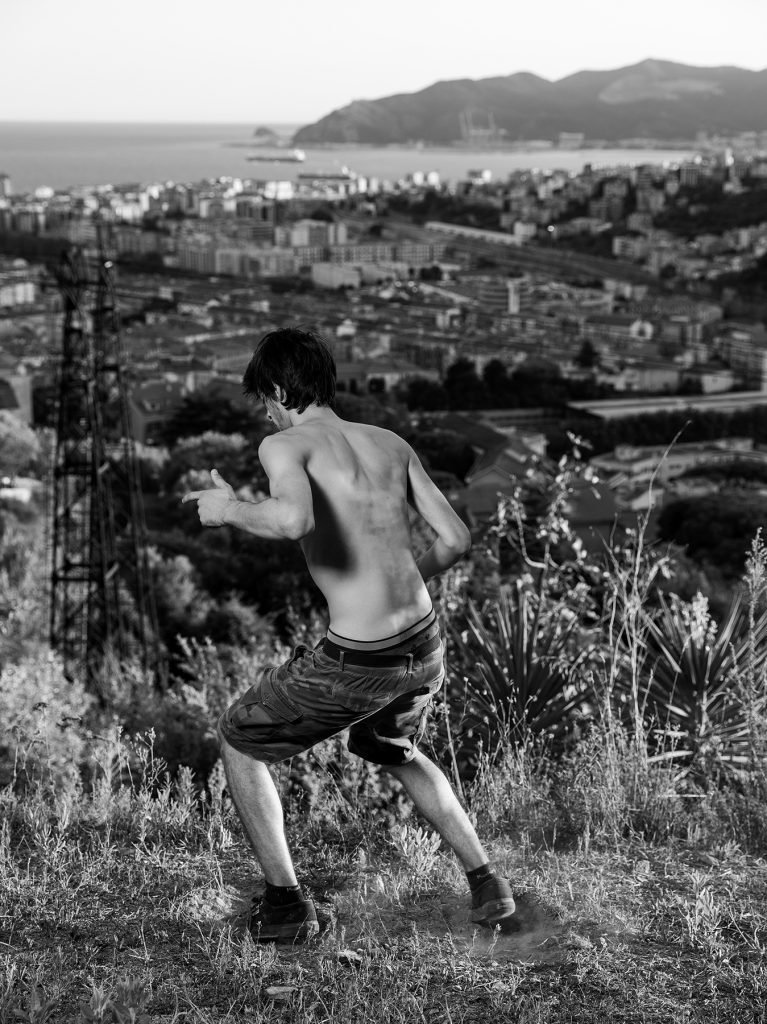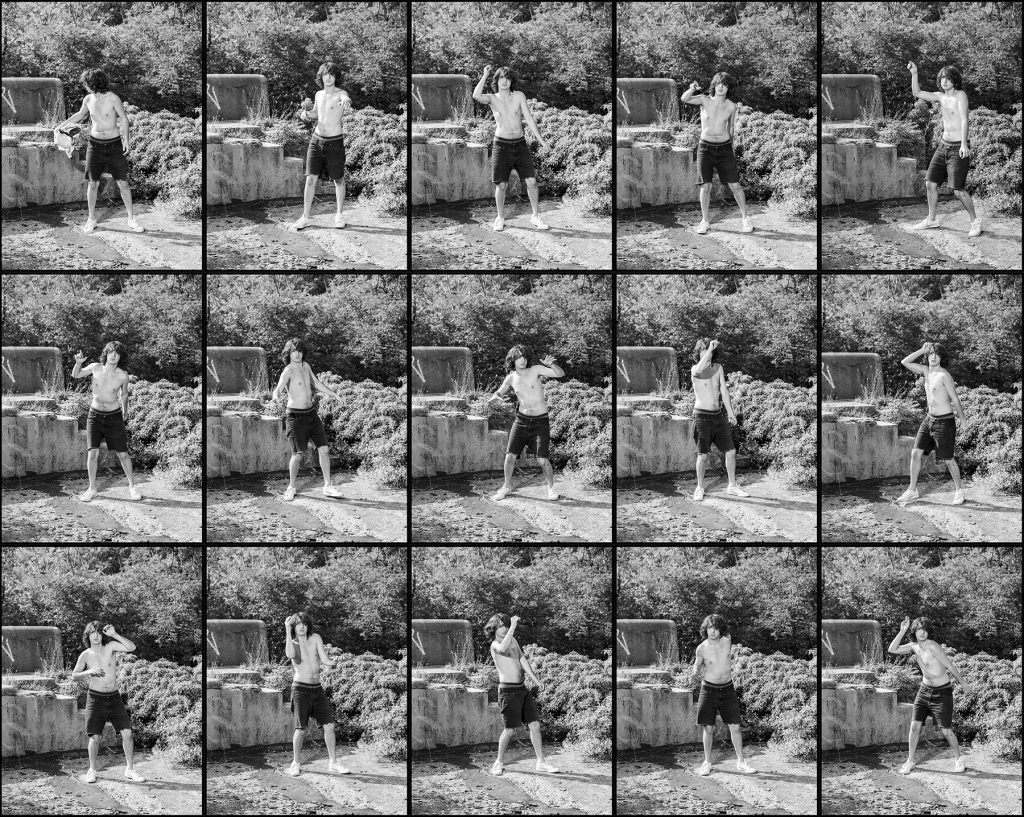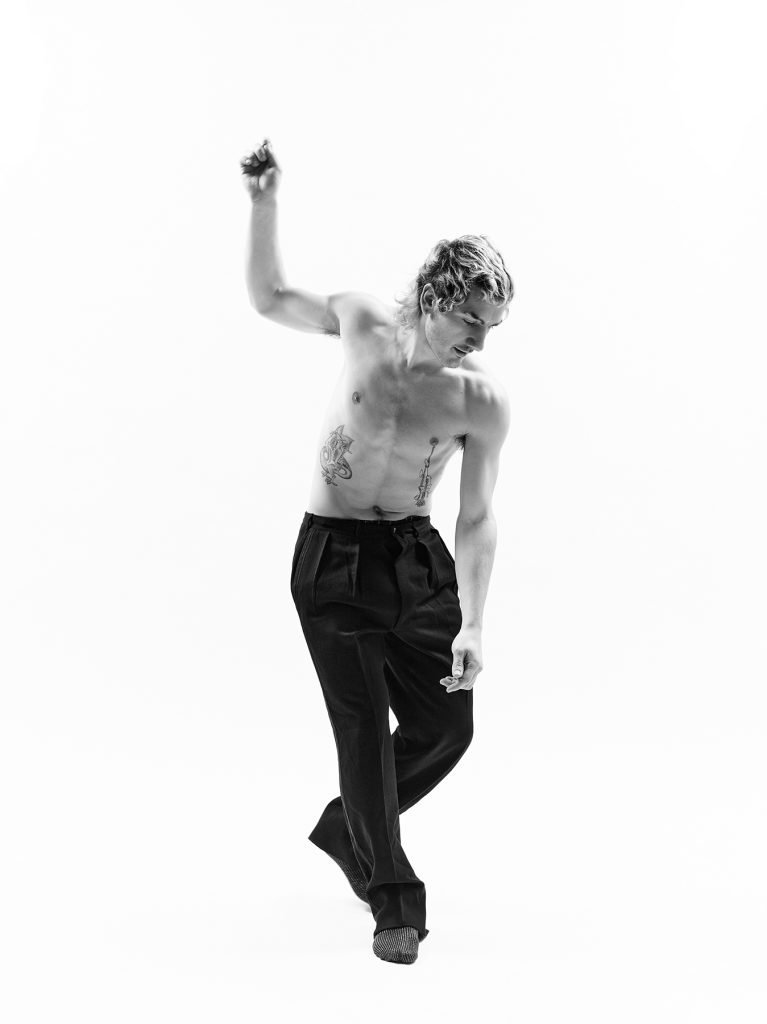











Simone Bergantini uses the ‘How To’ formula to help the less experienced user navigate what the artist calls a new visual exoticism. Bergantini has chosen the format of a manual as a tool to stimulate reflection on “how to do things” in a society that seems to have lost its bearings. As in coming-of- age novels, the work stresses the need for an evolution although is not made immediately clear who the protagonist is and to whom this process of maturation towards adulthood refers. Instead, it gives the impression that this must be a collective subject, one that tries to create self-managed spaces in order to evade the formal structures and institutions that are imposed on society as a form of control. Bergantini invites the reader to consider the creation of a system of social relations, which, by focusing on the present moment, frees the mind from the mechanisms that have been imposed on it by society. In order to do so, the author’s stra- tegy is to combine Rave dancing with the convenient format of a specialised manual, thus creating a unique area of expertise within which to deploy a range of skills that go beyond the subject matter. Page after page, the author shows doubt in the reader as to what the true conceptual core of the publication is. In the second half of the book, the attention to dance fades away, allowing a broader reflection to emerge, at times caustic, on visual art, fashion and society in general. Our certainties about the world have been wavering for some time now. However, this widespread malaise seems to have undergone a process of acceleration in 2020 the year of the pandemic and the lockdown, precisely when Bergantini began work on this project. In producing this simultaneously fake and real manual, it seems the artist wanted to take a break, in order to explore a new field where the essence of things can be fathomed, to rediscover the freedom that lies in self-expression, and strongly affirm the role of the artist. In order to remove himself from the confusion that surrounds him, Bergantini has chosen the book format, a writing style that is both ironic and didactic, and, of course, photography, although here used differently compared to his previous works. As an artist, Bergantini fills his work with all the things that life has given him: reading between the lines, we discover his passion for collecting, the right balance between amateurism and professionalism in photography, the author’s curiosity for tribal dance and the anthropology of the festival, as well as his views on the role of the teacher and their responsi- bility towards future generations. We acknowledge the strength of having something to say, but also the difficulty of understanding youth culture and narrating it. We encounter the love and the fear that are indispensable when plunging into new projects. This manual recounts things that are “differently true”. It proposes a reflection that also seems to indirectly address the art world, to which Bergantini himself belongs in particular, we think about those who turn to easy clichés instead of investing time in research. Everything and the opposite of everything. And yet, in the folds of Bergantini’s fiction is a lucid meditation on the present, that regards the fashion world as a voracious machine, where everything is deliberately swallowedup to favour the interests of a powerful culture industry with a will to expand. Caught in the grips of these dynamics, the visual arts lose their edge. Unable to ap- propriate the tools of other languages, they follow the path of those who, in theory, dominate the scene, sympathi- sing with fashion from an iconographic point of view as well. The progressive aesthetic elevation of the images published in the book seems to play with these aspects. With a reference to seventies manuals, the black and white photographs of the first pages show young dancers performing outdoors, surrounded by greenery. In the appendix, Bergantini takes us to a small village on the outskirts of the city of Chivasso. Here the author indulges in typical landscape photography in or- der to show us one of the places of our country – here a metaphor for what we really are, despite our persistent attraction to the foreign and which often leads us to follow other paths. The quiet of the countryside and the shots taken in the middle of nature give way to the white limbo, a symbol of the international fashion scene where, as the author notes, you “choose the look before choosing the pose”. This sounds a bit like “the packaging is more important than the content”, a reflection that may lead us to think about certain artistic environments which the artist seems to refer to. The white background of the images published in the second half of the book denotes a change of scene and attitude of the dancer. It is reminiscent of the aesthetics of certain fashion photographers, where even the performer seems to move with greater awareness, detached from the context but not less aut- hentic. This is made evident by the white terrycloth socks cited several times by the author, despite the uncertainty in its iconographic attribution. This book is a device, an apparatus wisely constructed by Simone Bergantini for a specific purpose. It was conceived to describe a particular set of concrete and discursive elements, here treated with lucid irony and shrewd foresight. It is an opportunity to set aside a redundant vision of the world, in search of a rich visual culture that is capable of interpreting the present.
Luca Panaro
L’artista utilizza la formula del How To te-matico pensato per aiutare l’utente meno esperto a muoversi in quello che lui stesso definisce un nuovo esotismo visivo. Simone Bergantini sceglie il manuale come dispositivo per riflettere sul “come fare” in una società che sembra avere perso la bussola. Come nei romanzi di formazione in questa opera si evidenzia la necessità di un’evoluzione, anche se non è chiaro chi sia il protagonista, a chi si riferisca questo processo di maturazione verso l’età adulta. Si ha l’impressione che si tratti piuttosto di un soggetto collettivo che cerca di creare degli spazi autogestiti, al fine di eludere le strutture e le istituzioni formali imposte dal controllo sociale. Bergantini sceglie di con- durre il lettore a creare un sistema di relazioni sociali, capace di concentrarsi sul presente e liberare la propria mente da meccanismi che sono stati imposti dalla società. Per fare questo utilizza l’escamotage della danza Rave e della manualistica di settore, ottiene in questo modo una zona autonoma all’interno della quale mettere in campo una serie di competenze che vanno oltre l’argomento trattato. Pagina dopo pagina l’autore insinua il dubbio nel lettore rispetto a quale sia il vero ancoraggio concettuale della pubblicazione, nella seconda metà del libro sfuma l’attenzione sul ballo e affiora una riflessione più ampia, a tratti pungente, sull’arte visi- va, la moda, la società in genere. Le nostre certezze sul mondo vacillano da tempo, ma questo malessere diffuso pare avere subito un processo di accelerazione proprio nel 2020 quando Bergantini lavora al progetto, l’anno della pandemia e del lockdown. Con questo finto/vero manuale l’artista sembra volere prendersi una pausa, fare ricerca in un campo nuovo che gli permetta di tornare a capire l’essenza delle cose, ritrovare la libertà di esprimersi, affermare con forza il ruolo dell’artista. Per togliersi dalla confusione che lo circonda Bergantini sceglie la forma del libro, una scrittura ironica e didascalica, senza però abbandonare la fotografia che utilizza in modo differente rispetto ai lavori precedenti. Come artista introduce nell’opera tutte le cose che la vita gli ha regalato, si legge tra le righe la sua passione per il collezionismo, il giusto equilibrio tra l’essere amatore e professionista in ambito fotografico, la curiosità verso il ballo tribale e l’antropologia della festa, il ruolo di docente e la responsabilità nei confronti delle future generazioni. La forza di avere qualcosa da dire, ma anche la difficoltà nel comprendere la gioventù, per raccontarla, l’amore e la paura indispensabili per lanciarsi in nuovi progetti. Un manuale che narra di cose diversamente vere, una riflessione che sembra riferirsi indirettamente anche al mondo dell’arte a cui Bergantini appartiene, il pensiero va a chi si rifugia in facili cliché invece di investire tempo nella ricerca. Tutto e il contrario di tutto. Ma tra le pieghe della finzione proposta da Bergantini si nasconde un pensiero lucido sul presente, che guarda al mondo della moda come macchina vorace dove tutto viene sapientemente fagocitato per favorire gli interessi di un’industria culturale potente e con pretese d’espansione. Stretta in questa morsa, l’arte visiva perde smalto, incapace di appropriarsi di strumenti in uso ad altri linguaggi, imita le movenze di chi sulla carta sembra dominare la scena e strizza l’occhio al fashion anche dal punto di vista iconografico. Il progressivo aumento di cura formale che assumono le immagini pubblicate nel libro sembra giocare con questi aspetti. Le fotografie in bianco e nero con riferimento alla manualistica anni settanta, mostrano nelle prime pagine giovani danzatori performare all’aperto immersi nel verde. Con un’appendice al progetto è proprio Bergantini ad accompagnarci in un piccolo borgo alla periferia della città di Chivasso, dove l’autore si lascia andare alla tipica fotografia di paesaggio per mostrarci uno dei luoghi del nostro Paese, metafora di ciò che siamo realmente nonostante la continua attrattiva estera che ci porta a correre su altri binari. La quiete della campagna e le riprese in mezzo la natura lasciano il posto al limbo bianco, simbolo della scena fashion internazionale dove si “sceglie il look prima di scegliere la posa”, dice l’autore, che suona un po’ come “il contenitore è più importante del contenuto”, riflessione che trova riscontro in certi ambienti artistici a cui l’artista sembra riferirsi. Lo sfondo bianco delle immagini pubblicate nella seconda metà del libro denota un cambio di scena e di atteggiamento del danzatore che ricorda l’estetica di certi fotografi di moda, dove anche il performer sembra muoversi con una maggiore consapevolezza, avulso dal contesto ma per questo non meno autentico, come dimostra il calzino di spugna bianco più volte citato dall’autore, nonostante l’incertezza nell’attribuzione iconografica. Questo libro è un dispositivo, un congegno costruito sapientemente da Simone Bergantini per svolgere una determinata funzione, concepito per descrivere un particolare insieme di elementi, concreti e discorsivi, trattati con lucida ironia e sagace lungimiranza, l’occasione per lasciare da parte una visione del mondo ormai sterile, alla ricerca di una proficua cultura visiva capace di farsi interprete del presente.
Luca Panaro